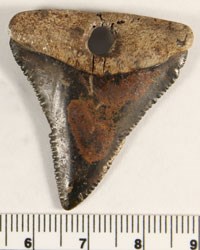Last updated: July 5, 2024
Article
Hopewell Culture Shark Teeth

NPS Photo / Andrew Weiland
Written by Park Guide Sarah Hinkelman
Do you know someone who has a fossil collection? Chances are you probably do! Fossils are the remains of prehistoric living creatures that have been preserved in petrified form or as a mold or cast in rock. They are found all over the world and widely collected. Did you know that the ancient people who were part of the Hopewell culture here in the Scioto River valley collected fossils too? Some of the most interesting fossils archeologists found in the earthworks here in Ohio are shark teeth!
Shark teeth arrived in Ohio from coastal waters in the hands of ancient peoples from the Scioto River Valley who traveled to the coast to participate in special quests to retrieve them; or they were brought by people from the eastern coast or up from the Gulf of Mexico, coming to participate in the religious ceremonies held at the magnificent earthwork complexes in southern Ohio. Whichever way they arrived in Ohio, these objects made a journey of 500 miles or more.

NPS Photo / Andrew Weiland

NPS Photo / Andrew Weiland
Precontact indigenous people likely collected from fossil deposits along the Chesapeake Bay area in Maryland, the eastern coast from North Carolina to the southern tip of Florida, and from a rather large deposit in the Gulf of Mexico. These ancient people did not have to wrestle the teeth from the mouths of the sharks themselves but found them shed in the coastal sands or mined them from inland deposits that were once part of the sea. These teeth are the remains of the ocean’s greatest and most magnificent predators, such as the great white shark (Carcharodon carcharias), which is still around today, and the extinct megalodon (Carcharocles megalodon) whose teeth can range from 3-7 inches! Sharks have lived in the ocean for over 400 million years and naturally shed their teeth constantly, similarly to how we lose our baby teeth, except some sharks have up to 15 rows of 48 teeth (that’s over 300 teeth at a time). It only takes about 10,000 years for a shark tooth to fossilize due to the environment the ocean sediments provide. You can only imagine how many shark teeth fossils get washed up on the beach by storms and other disturbances in the ocean floor, likely thousands every year!
The shark teeth found in the mounds and earthwork complexes in the Scioto River valley were likely a part of ceremonial clothing and displays. Most of the teeth found in Hopewell Culture National Historical Park have drill holes in the lower center portion of the tooth, where the tooth would have been held in place by the shark’s jaw. This hole might have been used to fasten the tooth on a cord or string to be either worn as a necklace, sewn onto clothing, or fastened to other ceremonial elements.
Over 105 shark teeth were recovered during archeological excavations at Mound City Group. These teeth must have been considered special to be buried in such a sacred place. Shark teeth are sharp and can be serrated -an attribute that embodies their fierce reputation as the ruthless hunters of the sea. The ancient peoples who practiced the Hopewell culture may have adorned themselves in the teeth and claws of powerful predators, such as bear, bobcat, wolves, and shark, to connect themselves to the characteristics of these animals. The people who were buried with these items might have been remembered as powerful socially and/or skillful in hunting.
Today, visitors to the East Coast’s sandy beaches search for fossilized shark teeth. If you visit gift shops along the beaches, you may find shark teeth jewelry for sale; even today we adorn ourselves in shark teeth as they still remind people of the power, strength, and fierceness of sharks!
